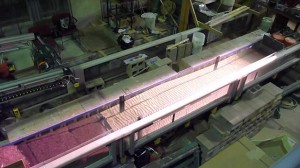Experimental Work on Wave-Generated Bedforms
I am working on a National Science Foundation funded project, working in collaboration with Taylor Perron (Massachusetts Institute of Technology), on experimental studies using a wave tank that we constructed at MIT. It consists of a closed-end acrylic channel 60 cm wide ´ 50 cm deep ´ 7 m long. We are using the tank to investigate the mechanisms by which symmetric, straight-crested wave ripples respond to changes in wave conditions. Wave ripple spacing is often used as a paleoenvironmental indicator, and modern ripples of various sizes are easily observed signatures of the interactions of bed topography and sediment transport. But there is evidence that ripple spacing is often out of equilibrium with rapidly changing wave conditions, and both ancient and modern ripples often contain complicated defects – deviations from straight, parallel crests – that are poorly understood. In this study we are determining how these self-organized bedforms respond to changes in wave conditions, and what role defects play in this response. There have been many prior experimental and field studies of wave ripples, but most have focused on the development of equilibrium ripple patterns. At present there is a very limited understanding of the rate and mechanisms by which ripples respond to changing waves conditions.
We are exploring the role that defects play in disequilibrium wave ripple evolution. In our laboratory wave tank experiments, we use time-lapse photography and image analysis to track the response of rippled beds to step changes in wave forcing. We developed a new numerical method for modeling the co-evolution of bed topography and oscillatory flow, and conducted numerical experiments to better understand the processes observed in the flume (Nienhuis et al., 2015).
Procedure: Time-lapse photography is used to monitor of experiments. Wave period, wave height, and water depth are measured during the experiment, and near-bed velocity and orbital diameter are calculated with linear wave theory. For our experiments, the bottom of the tank is filled with a 5 cm thick layer of fine sand with a D50 of 0.25 mm and a narrow size distribution. The sand is leveled with a vertical plate mounted on a sled that travels the length of the flume. Parallel grooves oriented perpendicular to the wave propagation direction is raked into the bed a few centimeters apart in order to increase the bed stress and sediment transport rate, thus reducing the equilibration time. This initial bed is subjected to constant wave conditions until the ripple wavelength approaches an approximately constant value and the bed reached a nearly stable configuration, which in most cases takes 3 to 6 hours. The wave conditions are then changed abruptly by adjusting the wave period and paddle displacement, and the bed is allowed to adjust to the new wave conditions for up to 12 hours. Wave periods in these experiments are between 2 and 4 seconds, and near-bed orbital diameters range from 7.5 to 15 cm. Photographs are taken every 30 s for the duration of the experiments.
Publications:
Nienhuis, J.H., Perron, J.T., Kao, J.C.T., and Myrow, P.M., 2015, Wavelength selection and symmetry breaking in orbital wave ripples: Journal of Geophysical Research: Earth Surface: v. 119, p. 2239–2257, doi:10.1002/2014JF003158

Wave Tank at MIT. Note paddle wave generator at end of tank on right and wave-damping beach on left.

Bifurcating crests in Precambrian strata of central Arizona. The bifurcations is one type of defect in small, straight-crested, wave ripples.
